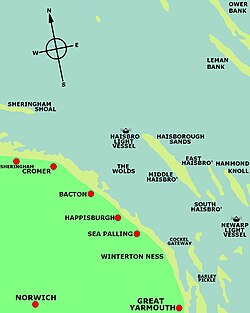The following is a description of Yarmouth Roads that appeared in The Nautical Magazine and Naval Chronicle for 1837. [3]
There have always been considered two principle channels or gatways into Yarmouth roads - one at the northern extreme called the Cockle gatway, or between Cockle and Barber sands on the one side, and the Sea Heads and Scroby on the other side; and the other called St. Nicolas gatway, leading in from the S.E. between the Corton sand on the one side, and the Kettle Bottom on the other. This latter was always used by the north sea fleet, and is still preferred by the larger class of merchant-vessels, and some deep laden colliers, to a secondary channel existing at the southern extreme of the roads; and it is to this principal channel into Yarmouth roads, that I am anxious in this communication, to draw the attention of my fellow seamen frequenting the eastern coast, and which I shall endeavour to do by an introductory remark or two.


